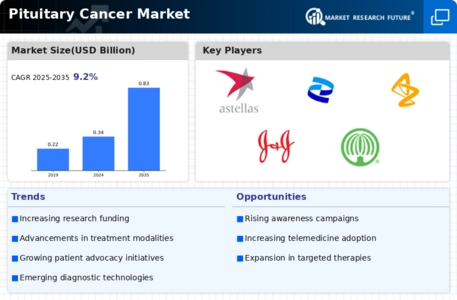Market Growth Projections
Increased Research Funding
The Global Pituitary Cancer Market Industry is benefiting from increased research funding aimed at understanding and treating pituitary tumors. Government and private organizations are allocating substantial resources to research initiatives, which are crucial for developing new therapies and improving diagnostic tools. For example, initiatives funded by national health organizations have led to breakthroughs in genetic research related to pituitary cancers. This influx of funding not only fosters innovation but also raises awareness about the disease, potentially leading to earlier diagnoses and better treatment options. As research progresses, the market is likely to see a surge in novel therapies and improved patient management strategies.
Growing Awareness and Education
There is a growing emphasis on awareness and education regarding pituitary cancer, which is positively impacting the Global Pituitary Cancer Market Industry. Campaigns aimed at educating both healthcare providers and the public about the symptoms and treatment options for pituitary tumors are gaining traction. This increased awareness is likely to lead to earlier diagnosis and treatment, which can significantly improve patient outcomes. Furthermore, educational initiatives are being supported by various health organizations, which are crucial in disseminating information about the disease. As awareness grows, the market is expected to expand, reflecting the need for comprehensive care and support for affected individuals.
Advancements in Treatment Modalities
Innovations in treatment modalities for pituitary cancer are significantly influencing the Global Pituitary Cancer Market Industry. The development of targeted therapies and minimally invasive surgical techniques has improved patient outcomes and reduced recovery times. For instance, the introduction of endoscopic transsphenoidal surgery has revolutionized the approach to pituitary tumors, allowing for greater precision and reduced complications. These advancements not only enhance the quality of care but also contribute to the market's expansion, as they encourage more patients to seek treatment. The anticipated compound annual growth rate of 8.49% from 2025 to 2035 underscores the potential for continued growth in this sector.
Rising Incidence of Pituitary Tumors
The Global Pituitary Cancer Market Industry is witnessing a notable increase in the incidence of pituitary tumors, which is a primary driver of market growth. According to recent data, the prevalence of these tumors is expected to rise due to factors such as improved diagnostic techniques and increased awareness among healthcare professionals. This trend is particularly evident in regions with advanced healthcare systems, where early detection rates have improved. As a result, the market is projected to grow from 0.34 USD Billion in 2024 to 0.83 USD Billion by 2035, reflecting a growing need for effective treatment options.
Emerging Markets and Healthcare Infrastructure Development
The Global Pituitary Cancer Market Industry is experiencing growth due to the emergence of new markets and the development of healthcare infrastructure in various regions. Countries with developing healthcare systems are increasingly investing in cancer care, including the treatment of pituitary tumors. This investment is fostering the establishment of specialized cancer centers and enhancing access to advanced treatment options. As these markets mature, they are likely to contribute significantly to the overall market growth. The anticipated increase in market size from 0.34 USD Billion in 2024 to 0.83 USD Billion by 2035 illustrates the potential of these emerging markets in shaping the future of pituitary cancer treatment.















